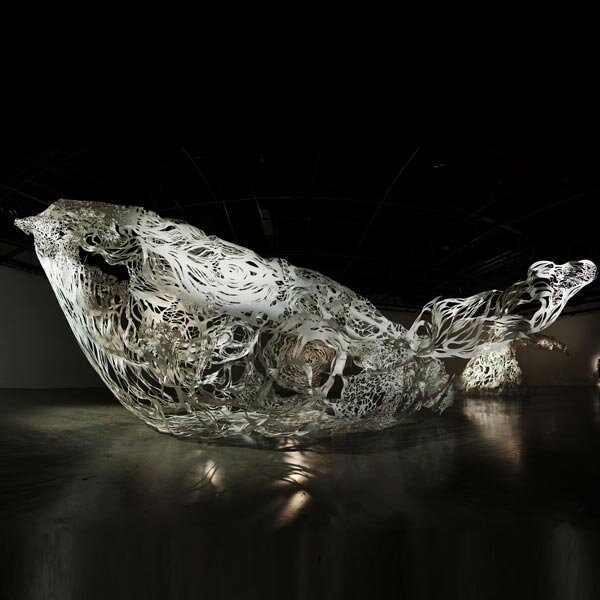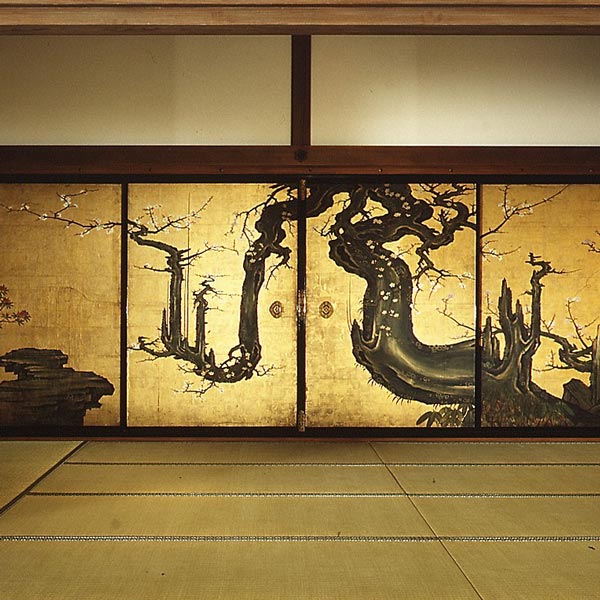© Rieko Morita, Ryugu - The Dragon Palace, 2003. All rights reserved.
Rieko Morita is one of the best-known and respected nihonga artists working today. She has spent more than 30 years pursuing her pioneering artistic vision of Japanese heritage.
Morita’s evocative artworks tell intricate stories of Japan’s stunning natural world and cultural life. In 2007 she was asked to complete her signature floral paintings on the 800-year-old cedar doors in the main hall of Kyoto’s famous Kinkakuji - Golden Pavilion.
Japanese heritage is very much part of the essence of nihonga, which literally translates to Japanese painting. For 150 years this art movement has encouraged the use of traditional Japanese themes and materials in fine art. If you are unfamiliar with nihonga, you can take a look at our concise guide, or read on to hear from an expert practitioner!
We caught up with Morita to talk about her work, inspiration, and the role of nihonga in contemporary Japanese art.
© Rieko Morita, Fuji Musume – Wisteria, 2010. All rights reserved.
Japan Objects (JO): I am really fascinated by the portrayals of Kyoto’s Maiko and Geiko in your paintings. They are extremely powerful and at the same time very personal. Can you tell us about what this unique culture means to you?
Rieko Morita (RM): The impenetrable world of Kagai [Flower Street, an area in Kyoto where the Geiko live and work] seems veiled in mystery. There are many great works of art on the theme of Maiko, not just nihonga paintings, but also plays and literature. I first became interested in Maiko wondering what made them so fascinating to writers. It was only a minor interest when I first started drawing them, but bit by bit I was truly taken in by the mysterious charm of the ‘walking traditional craft’ of the world of Maiko.
© Rieko Morita, Maiko – Posh, 2001. All rights reserved.
In Kagai, the old customs and rituals, which have been completely forgotten in society in general, are still handed down unchanged. It felt as though it awoke a sense of the beauty of old Japan that had been dormant in me. Behind all their glamor, you can find the daily training in the arts, and the many years that these women have spent cultivating the correct manners and conventions. I am impressed by their dedication to this life in the present day, while carrying the weight of the history and traditions of Kagai.
© Rieko Morita, Akisokyu – Autumn Clear Skies. All rights reserved. Available at Alexcious.
JO: You have become well known for your intimate studies of many different species of flowers, such as this spider chrysanthemum. How did you develop such a close interest in these flowers?
RM: I think it is living in Kyoto that has made me into a painter of flowers. The city of Kyoto itself is a museum that gives me a lot of insight and inspiration. Kyoto enjoys a gentle pace and cherishes its changing seasons. Living here means being surrounded by the precious cultural heritage of those that came before us, which has influenced my work.
When I first started sketching flowers, I wouldn’t get very far before I felt a strong urge to give up. But with patience, and after many attempts, eventually I could feel my brush began to flow more smoothly. I became hooked on the pleasure of painting flowers, and now it’s as though I go on a journey with them as they change from season to season.
© Rieko Morita, Five Shades of Camellia. All rights reserved. Available at Alexcious.
JO: The myriad flowers that you paint so meticulously have many meanings in Japanese culture. What meanings do they represent for you?
RM: The nature of flowers seems to embody the cycle of life, and I think that as an artist I can take this aspect and express it in my work.
When I feel the wind rustle through the trees, or listen to the hum of birds and insects among the flowers busying about their daily lives, it makes me realize that I am also a part of the same natural world.
© Rieko Morita, Springtime, 2011. All rights reserved.
The touch of a short-lived petal makes me feel that harmonious energy. The branches that support the flowers, the leaves turning to the sun, the roots spreading through the earth: every part has its role to play. Eventually flowers become fruits and seeds, and life is passed on to the next generation.
I think that each flower shines with its own individual spirit in the same way that people are all different. If you can listen to what they say without words and draw each flower with compassion, then they will appear to blossom vividly within the painting.
© Rieko Morita, Miyako-Odori, 2010. All rights reserved.
JO: Nihonga is perhaps not as well known internationally as it should be, but it is truly one of the greatest artistic treasures of Japan. It’s a movement that celebrates distinctly Japanese forms of artistic expression. What are some of characteristics that sets nihonga apart from western art?
RM: I think that some of the things which draw people to the uniqueness of nihonga are the striking colors. The use of bold outlines and deeply harmonious colors without focusing on shadows was a revelation to 18th Century European artists, particularly the impressionists.
In nihonga the use of gold leaf as though to screen out the background, allows the central motif to emerge more clearly. The bold use of blank space, or the incorporation of both real and imagined elements into a composition creates a dramatic tension.
In addition, the unrestricted cutting and compilation you see in nihonga are effective ways to allow the viewer’s imagination to incorporate the world outside the painting, either by adding in elements from other places, or hiding some of the central motif to reveal only those parts that are necessary.
© Rieko Morita, Sakura Moon Night, 2012. All rights reserved.
JO: One of the essential features of nihonga is the use of traditional Japanese materials, in particular the colors as you mentioned. Can you tell us about how you achieve these distinctive colors?
RM: The three main color elements are mineral pigments, black sumi ink and chalk (gofun). Mineral pigments are produced from naturally occurring minerals (malachite, lapis lazuli, etc) through an exhaustive process, where they are crushed and repeatedly refined to remove impurities and to achieve a particular particle size.
© Rieko Morita, Peach Festival, 2011. All rights reserved. Available at Alexcious.
Gofun, or chalk powder, produces a pure white color unlike anything else. It is made from crushed oyster shells, which must also then be refined to remove impurities. The artist can mix these with glue and water to fix them to the washi paper or silk surface. But all these materials are only available to us thanks to the techniques that have been passed on through generations of skilled craftspeople.
© Rieko Morita, Iris, 2010. All rights reserved.
JO: These kind of natural pigments must respond quite differently to synthetic paints. What are some of the different techniques that nihonga artists employ when working with these traditional colors?
RM: The technique of bokashi (gradation) allows you to make very delicate gradations in color by dabbing the pigment onto just one part of a moistened brush and placing it onto the surface (in nihonga it is said that we place the color, rather than paint it). Another technique is to use one brush to place the pigment along the outline, and at the same time use another wet brush to very quickly blur the color.
© Rieko Morita, Camellia, 2010. All rights reserved.
Tarashikomi (blending) is a technique of placing two or three different shades of pigment onto the surface at the same time, then altering the color according to the relative densities and dryness of each.
Kasane-Nagashi (overlaying) involves adding several very thin layers of mineral pigment to a tilted surface over time, which causes the base color to stand out slightly from between the gaps in the particles of the pigment.
© Rieko Morita, Maiko (Chrysanthemum Season), 2001. All rights reserved.
JO: Apart from working with the traditional elements of nihonga, your work has always been experimental. And I think that’s what is special about your paintings – the determination to try new things and the courage to break away from tradition. What inspired you to create your signature style?
RM: To fully realize the unique transparency and vivid colors of nihonga mineral pigments I wanted to created a new type of nihonga painting. I wanted to use a blend of east and west, by incorporating the light and shadow of western style art into the traditional painting techniques that have been handed down to us today. Through a process of trial and error I have arrived at this style.
© Rieko Morita, Blooms, 2011. All rights reserved.
In Japanese, the culture of these islands is referred to as Wa (和). But wa also has another meaning of harmonizing, as in the harmonious combination of two or more elements. Japan, an island nation at the end of the silk road, has been continuously accepting the best parts of many foreign cultures since ancient times. These have been fused and transformed into a new unique visual culture which has provides both comfort and excitement to viewers. I’m proud to be part of a Japanese culture that is so flexible and accommodating.
JO SELECTS offers helpful suggestions, and genuine recommendations for high-quality, authentic Japanese art & design. We know how difficult it is to search for Japanese artists, artisans and designers on the vast internet, so we came up with this lifestyle guide to highlight the most inspiring Japanese artworks and designs for your everyday needs.

















LIFESTYLE | July 28, 2023